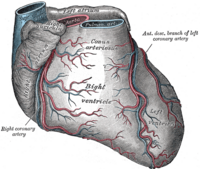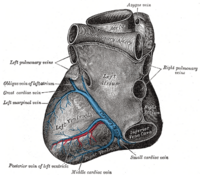Coronary circulation
| Coronary circulation | |
|---|---|
 |
|
| An anterior left coronary artery. | |
 |
|
| Base and diaphragmatic surface of heart. | |
| MeSH | Coronary+Vessels |
Coronary circulation is the circulation of blood in the blood vessels of the heart muscle (the myocardium). The vessels that deliver oxygen-rich blood to the myocardium are known as coronary arteries. The vessels that remove the deoxygenated blood from the heart muscle are known as coronary veins.
The coronary arteries that run on the surface of the heart are called epicardial coronary arteries. These arteries, when healthy, are capable of autoregulation to maintain coronary blood flow at levels appropriate to the needs of the heart muscle. These relatively narrow vessels are commonly affected by atherosclerosis and can become blocked, causing angina or a heart attack. (See also: circulatory system.) The coronary arteries that run deep within the myocardium are referred to as subendocardial.
The coronary arteries are classified as "end circulation", since they represent the only source of blood supply to the myocardium: there is very little redundant blood supply, which is why blockage of these vessels can be so critical.
Contents |
Coronary anatomy

The exact anatomy of the myocardial blood supply system varies considerably from person to person. A full evaluation of the coronary arteries requires cardiac catheterization or CT coronary angiography.
In general there are two main coronary arteries, the left and right.
- Right coronary artery
- Left coronary artery
and also posterior coronary artery
Both of these arteries originate from the beginning (root) of the aorta, immediately above the aortic valve. As discussed below, the left coronary artery originates from the left aortic sinus, while the right coronary artery originates from the right aortic sinus.
Variations
Four percent of people have a third, the posterior coronary artery. In rare cases, a person will have one coronary artery that runs around the root of the aorta.
Occasionally, a coronary artery will exist as a double structure (i. e. there are two arteries, parallel to each other, where ordinarily there would be one).
Coronary artery dominance
The artery that supplies the posterior descending artery (PDA)[1] (a.k.a. posterior interventricular artery) determines the coronary dominance.[2]
- If the posterior descending artery (PDA) (a.k.a. posterior interventricular artery) is supplied by the right coronary artery (RCA), then the coronary circulation can be classified as "right-dominant".
- If the posterior descending artery (PDA) is supplied by the circumflex artery (CX), a branch of the left artery, then the coronary circulation can be classified as "left-dominant".
- If the posterior descending artery (PDA) is supplied by both the right coronary artery (RCA) and the circumflex artery, then the coronary circulation can be classified as "co-dominant".
Approximately 70% of the general population are right-dominant, 20% are co-dominant, and 10% are left-dominant.[2] A precise anatomic definition of dominance would be the artery which gives off supply to the AV node i.e. the AV nodal artery. Most of the times this is the Right Coronary Artery.
Blood supply of the papillary muscles
The papillary muscles tether the mitral valve (the valve between the left atrium and the left ventricle) and the tricuspid valve (the valve between the right atrium and the right ventricle) to the wall of the heart. If the papillary muscles are not functioning properly, the mitral valve may leak during contraction of the left ventricle. This causes some of the blood to travel "in reverse", from the left ventricle to the left atrium, instead of forward to the aorta and the rest of the body. This leaking of blood to the left atrium is known as mitral regurgitation. Similarly, the leaking of blood from the right ventricle through the tricuspid valve and into the right atrium can also occur, and this is described as tricuspid insufficiency or tricuspid regurgitation.
The anterolateral papillary muscle more frequently receives two blood supplies: left anterior descending (LAD) artery and the left circumflex artery (LCX).[3] It is therefore more frequently resistant to coronary ischemia (insufficiency of oxygen-rich blood). On the other hand, the posteromedial papillary muscle is usually supplied only by the PDA.[3] This makes the posteromedial papillary muscle significantly more susceptible to ischemia. The clinical significance of this is that a myocardial infarction involving the PDA is more likely to cause mitral regurgitation.
Coronary flow


During contraction of the ventricular myocardium (systole), the subendocardial coronary vessels (the vessels that enter the myocardium) are compressed due to the high intraventricular pressures. However, the epicardial coronary vessels (the vessels that run along the outer surface of the heart) remain patent. Because of this, blood flow in the subendocardium stops. As a result most myocardial perfusion occurs during heart relaxation (diastole) when the subendocardial coronary vessels are patent and under low pressure. This contributes to the filling difficulties of the coronary arteries. Compression remains the same. Failure of oxygen delivery caused by a decrease in blood flow in front of increased oxygen demand of the heart results in tissue ischemia, a condition of oxygen debt. Brief ischemia is associated with intense chest pain, known as angina. Severe ischemia can cause the heart muscle to die from hypoxia, such as during a myocardial infarction. Chronic moderate ischemia causes contraction of the heart to weaken, known as myocardial hibernation.
In addition to metabolism, the coronary circulation possesses unique pharmacologic characteristics. Prominent among these is its reactivity to adrenergic stimulation. The majority of vasculature in the body constricts to norepinephrine, a sympathetic neurotransmitter the body uses to increase blood pressure. In the coronary circulation, norepinephrine elicits vasodilation, due to the predominance of beta-adrenergic receptors in the coronary circulation. Agonists of alpha-receptors, such as phenylephrine, elicit very little constriction in the coronary circulation.
Anastomoses
When two arteries of the coronary circulation join, dual blood flow to a certain area of the myocardium occurs. These junctions are called anastomoses. If one coronary artery is obstructed by an atheroma, the second artery is still able to supply oxygenated blood to the myocardium. However this can only occur if the atheroma progresses slowly, giving the anastomoses a chance to proliferate. Under the most common configuration of coronary arteries, there exist two anastomoses on the posterior side of the heart. More superiorly, there is an anastomosis between the circumflex artery (a branch of the left coronary artery) and the right coronary artery. More inferiorly, there is an anastomosis between the anterior interventricular artery (a branch of the left coronary artery) and the posterior interventricular artery (a branch of the right coronary artery)....
See also
References
- ↑ 00460 at CHORUS
- ↑ 2.0 2.1 Fuster, V; Alexander RW, O'Rourke RA (2001). Hurst's The Heart (10th ed.). McGraw-Hill. p. 53. ISBN 0-07-135694-0.
- ↑ 3.0 3.1 Voci P, Bilotta F, Caretta Q, Mercanti C, Marino B (1995). "Papillary muscle perfusion pattern. A hypothesis for ischemic papillary muscle dysfunction". Circulation 91 (6): 1714–8. PMID 7882478.
|
||||||||||||||||||||||||||||||||||
|
||||||||||||||||||||||||||||||||||||||